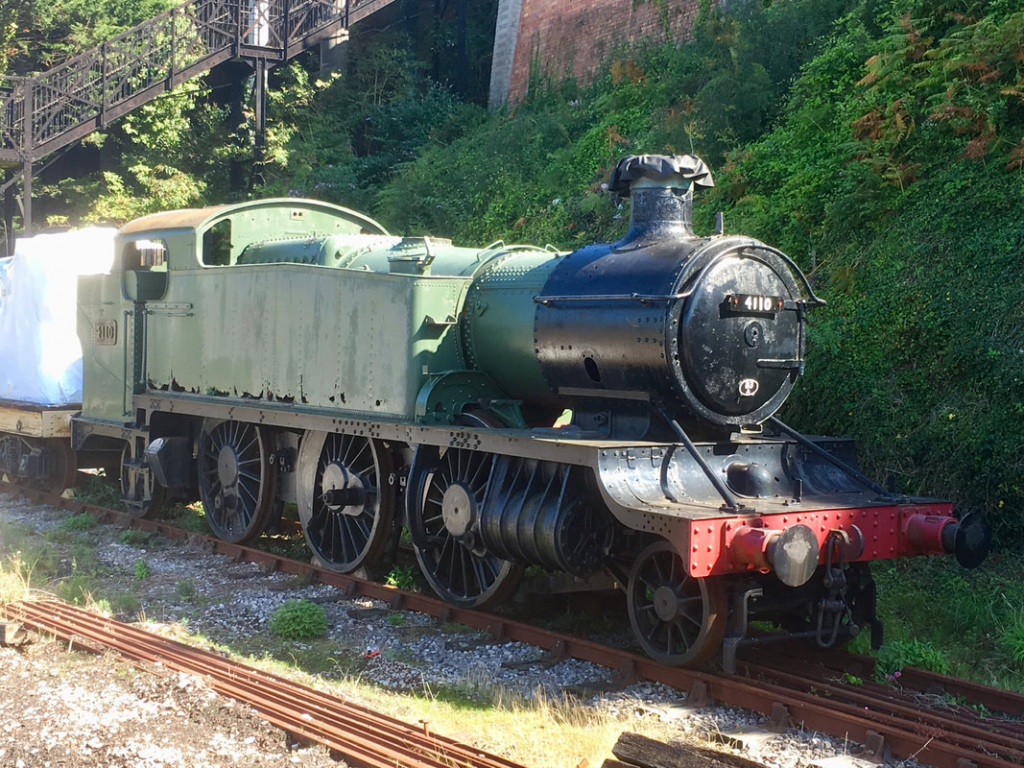Following the discovery of what was under the sheet at Kingswear, the scribe dropped a line to the Cornwall Railway Society Webmaster.

The story of what was under the sheet.
Dear Keith,
The engine lying on a WARFLAT in a siding at Kingswear is a tenuous excuse to expand on the fate of the vessel over the years.
My old pal, Bob Le Marchant, graduate of the Camborne School of Mines, hero of the Festiniog, originator of the mine train at Morwellham, was brought up in Paignton and knows the area well. He remembers the colliers offloading at Kingswear for Torquay Gas Works and the lightships tied up at Philips’s yard on the Dart.
Sending him the piece on Britannia Crossing, I asked him if he’d noticed the polythene-covered load at Kingswear when he was there recently. He came back with this:-
“I remember my efforts to save the Compton Castle, and base it at Morwellham. I had a promise of the money to buy the vessel from the Transport Trust, but not the money to repair it. That was when I bought my first welder and taught myself to weld. But the Trustees did not share my vision. Then it was bought by a publican in Looe, and towed there. Cut off the superstructure to get it under Looe Bridge. Placed it on a custom built slip up the West Looe boat yard (there was a rail system there). But the boiler was cut up and thrown out of a hole cut in the bottom. At about this time I gave up interest, and the engines were taken out for a museum ” – in the Isle of Wight”, and she was towed to Truro. Makes. me sad to see her there.”
Asked if he minded this being shared with the C.R.S., he replied:-
Yes, share my writing by all means. I still have builder’s plans somewhere – donated by the PSPS. I went with my Dad to Kingsbridge to look over the Compton Castle when I heard that it was under a daily penalty by the Council to have it removed. Looking in the porthole to the engine room, all was bright and shiny, with a carpet on the engine room floor. I had visions of running it from Morwellham with a three piece musical combo (my Grandpa was a band leader), and cut glass sundae dishes. I knew I could really do the thing others couldn’t!! It is all about doing it with passion, and keeping the woman in a business suit well away.
Then he was asked what his particular interest was in the vessel. Was it the steam, the age, the origin on the Dart or the paddles? You will know that Morwellham is the highest practicable navigation on the Tamar, although it is tidal as far as Gunnislake Weir, and paddle-driven vessels are better for shallow drafts. He replied:-
Paddles are good, but it was the whole package: –
· Steam engine in good working condition (in my book certainly, though not in others’opinion My good friend Roger Pridham (boiler makers) could have easily re-tubed the existing boiler);
· Beautiful boat;
· Local boat (I can just remember them on the Dart);
· Having a dock at Morwellham to keep it in;
· Needing something to put in the dock to give the Quay ‘life;’
· Having just built a big slipway at Morwellham that would allow repairs to be done in house;
· My love of the best of the Edwardian lifestyle (promenades, decent clothing, seaside culture, children in secure family groups;
· Something exciting that would fulfil my life for the rest of it (I would still be driving it today if it had been done).
And so on. I know/think I could even have made it all pay quite well – if you could have kept it ENGINEER/MANAGER, rather than woman in business suit manager. But paddles certainly make the whole thing a public spectacle, – as the Kingswear Castle is now.
So, when I visit the sad remains of the Compton Castle in Truro, I ponder all these things, and come to the conclusion that I have spent much of my life “swimming against the tide”, as I am sure you feel sometimes.
Valuable insight though this is, it’s probably too much for your pages with such a tenuous connection to railways. If you don’t post it, then I hope it will have been of interest to you. And you may know a few chaps who would also like to read Bob’s words.
